On World Environment Day, ‘Eco-Champions’ M. Rajesh, M. Satish Kumar and T. Thomas David fittingly took home a cash prize of 50,000 for their low-cost IoT-based sensor for effective water management.
With its vision of achieving a simultaneous economic growth along with environmental management for an improved quality of life in Telangana, the State Pollution Control Board (TSPCB) has been actively engaged in a host of related measures such as the phasing out of single-use plastics, laying out guidelines for effective waste disposal (e-waste, biomedical waste and so on), monitoring of effluents and many more. In a bid to create more awareness about ‘green’ matters, the Board recently organised a 5-day ‘Eco-Champions Hackathon’ for graduates and undergrads soliciting ideas and solutions to problems under two major themes. While Theme One revolved around the reduction of single use plastics, Theme Two dealt with water conservation and a reduction in its overall consumption. PhD students from the Lab of Spatial Informatics (LSI), Rajesh Muddu and Satish Mummidivarapu teamed up with Research Scholar Thomas David from the Signal Processing and Communication Research Centre (SPCRC) to provide an effective water management solution.
AI-based solution
Out of a total 314 teams that had registered for the hackathon, the IIITH team was one of the 25 shortlisted for the finals in Theme Two. TSPCB invited ideas related to the theme such as low cost technologies for treatment of sewage water and reuse, cost-effective community rain water harvesting technologies, innovative, energy efficient and economical solutions for reducing fresh water demand in agricultural, industrial and other water intensive sectors, policy or regulatory or legal intervention for efficient water management and effective control of water exploitation and many others. Rajesh, the team lead and others chose to develop a low-cost IoT sensor in response to the call for ‘Internet of Things (IoT) and Artificial Intelligence (AI) based device for effective water management in cities or large-scale industries.

Team Efforts
As students of LSI, Rajesh and Satish are actively involved in a DST-funded project where they are currently developing a DSS (Decision Support System) tool for real time water quality monitoring of the Bhadra river. “While the research project deals with real-time monitoring of water quality, for the hackathon we decided to focus on monitoring water quantity,” emphasises Satish. With water flow consumption and leakage detection being one of the focus areas of research at the Smart City Living Lab, expertise related to sensors was brought in by Thomas David, an Electronics and Communications Engineering student. Ably mentored by Prof. K S Rajan, Prof. Rehana Shaik and Prof. Sachin Chaudhari, the formidable team decided to develop and deploy affordable sensors that could not only measure water flow rates to optimise usage but also monitor the water levels in tanks to flag leaks if any, thereby reducing wastage. “We integrated the sensors with an Arduino-based platform, enabling real-time monitoring and data collection. The collected data is wirelessly transmitted to a central server or mobile app, allowing users to track their water consumption patterns, identify inefficiencies, and make informed decisions for effective water management,” explains Rajesh.
Superiority Of The Solution
Current water tank monitoring methods involve the use of floating balls or float switches that complete a circuit once a certain water level is reached. And then there are capacitive sensor-based technology sensors that complete a circuit upon contact with water. None of these solutions are IoT-based and the latter are in fact prone to corrosion since they are not water proof. The IIITH team’s solution was based on ultrasonic sensors that can gauge the exact volume of water in the tank without relying on indexes. Similarly, water consumption is typically measured with the help of digital meters. However, these are expensive and rely on ultrasonic methods. The team proposed the use of flow meters which when used in conjunction with hall effect sensors are cheap and easily programmable for calibration whenever required.
The data-driven approach which leverages digital innovation and technology caught the eye of the jury because it enables remote access to consumption data, facilitates proactive leak detection and supports sustainable water resource management. What made it come out on top though was its use of inexpensive parts making it a scalable solution that can be adapted to various settings thereby scoring on widespread implementation and impact too.

Sarita Chebbi is a compulsive early riser. Devourer of all news. Kettlebell enthusiast. Nit-picker of the written word especially when it’s not her own.


Next post